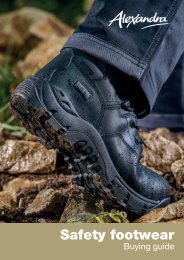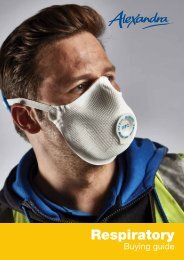Alexandra Hand Protection Buying Guide
Create successful ePaper yourself
Turn your PDF publications into a flip-book with our unique Google optimized e-Paper software.
<strong>Hand</strong> protection<br />
<strong>Buying</strong> guide
<strong>Hand</strong> protection<br />
<strong>Buying</strong> guide<br />
Choosing the right hand protection<br />
The most effective and reliable way to prevent skin problems is to design and operate processes to avoid contact with harmful substances.<br />
When you select protective gloves, base your choice on the work, the wearer and the environment they work in. You need to consider the<br />
following five factors:<br />
• Identify the substances handled.<br />
• Identify all other hazards.<br />
• Consider the user - size and comfort.<br />
• Consider the task.<br />
• Consider the type and duration of contact.<br />
Identify the substances handled<br />
<strong>Alexandra</strong> offers a variety of gloves that differ in design, material and thickness. No glove material will protect against all substances nor will it<br />
protect against a specific substance forever.<br />
To protect hands from substances/chemicals choose a glove that meets the European Standard EN374-3, but make sure the glove material you<br />
choose protects against the substances being handled. Please refer to the European standards chart below for further information relating to certain<br />
types of protection.<br />
More info<br />
online<br />
Industrially<br />
launderable<br />
• Substances in products: Some products contain substances that can harm the skin or enter the body through skin contact. The product label or<br />
material safety data sheet will tell you if this is applicable.<br />
• Substances created by work processes and ‘natural’ substances: Not all harmful substances come in labelled containers. Substances can be<br />
generated during work activities (e.g. wood dust from sanding or solder fumes). Remember that handling some Shower ‘natural’<br />
Water<br />
substances<br />
Water<br />
like foods<br />
Water<br />
and<br />
resistant resistant repellent proof<br />
flowers can cause skin problems too.<br />
Prolonged or frequent contact with water, particularly in combination with soaps and detergents, can cause dermatitis. ‘Wet work’ is the term used<br />
to describe tasks in the workplace that can cause this. To protect the hands from ‘wet work’ choose a glove that meets the European Standard<br />
Best buy Best value Stretch<br />
EN374-2, this shows that the gloves are waterproof.<br />
fabric<br />
£<br />
Flame<br />
retardant<br />
Thermal<br />
EN149<br />
respiration<br />
Coolte<br />
Moistu<br />
wicking<br />
EN352<br />
ear<br />
European standards<br />
Developed to enable assessment of intermediate and complex gloves. All<br />
conform to EN420, other standards relate to certain types of hazards.<br />
The 89/686 PPE Directive has been reviewed due to the insufficient level of<br />
security with all gloves. A new abrasion test and cut resistance test has now<br />
been introduced.<br />
EN374-2:<br />
EN374-3:<br />
EN407:<br />
EN420:<br />
EN455:<br />
EN511:<br />
EN1186:<br />
Determination of resistance to water penetration<br />
Determination of resistance to permeation by chemicals<br />
Protective gloves against thermal risks<br />
General requirements for gloves<br />
Medical gloves<br />
Protective gloves against cold<br />
Food contact<br />
EN388 Mechanical hazards<br />
Abrasion resistance<br />
Standard cut resistance<br />
Tear resistance<br />
Puncture resistance<br />
New cut resistance<br />
Impact<br />
Available<br />
sizes<br />
All trilby hats<br />
XS - L<br />
Menswear<br />
Shock<br />
absorption<br />
Available<br />
sizes<br />
Womenswear<br />
Interactive<br />
Machine<br />
washable<br />
Chemical<br />
protection<br />
Petrol & chemical<br />
resistant<br />
EN397<br />
hard hat<br />
4 3 4 3 B P<br />
Electric arc<br />
EN1149<br />
EN1149<br />
antistatic<br />
S<br />
prot
Identify all other hazards for<br />
hands and consider the type and<br />
duration of contact<br />
Identify any other hazards present. For example, is there a risk of<br />
abrasion, cuts, puncture or high temperature? There are chemical<br />
protective gloves that also give protection against mechanical hazards<br />
(those marked EN388) and thermal hazards (those marked EN407).<br />
If the gloves are being worn for a short time intermittently or for long<br />
periods, comfort is more important. Generally thicker and robust gloves<br />
offer greater protection than thinner gloves, however thinner gloves<br />
offer better dexterity.<br />
Size and comfort<br />
Gloves should fit the wearer. Tight gloves can make hands feel tired<br />
and loose their grip. Gloves that are too large can create folds; impair<br />
work and be uncomfortable. Involve employees in the selection process<br />
and give them a reasonable choice to pick from. <strong>Hand</strong>s can also sweat<br />
inside gloves making them uncomfortable to wear. Getting staff to take<br />
glove breaks, removing gloves for a minute or so before hands get too<br />
hot and sweaty, can help air the hands.<br />
Disposable gloves guide<br />
We stock a wide range of disposable gloves in a variety of materials<br />
and sizes.<br />
The right type of material will be determined by the task you need to<br />
perform. For example, latex gloves are not a good option when working<br />
with oil-based or chemical substances.<br />
Users who suffer from allergies to natural rubber proteins should also<br />
avoid latex gloves and find a more suitable alternative among vinyl,<br />
nitrile or vitrile gloves.<br />
Choosing a glove that fits properly is also important: gloves that are too<br />
large can compromise safety and reduce productivity, but if they are too<br />
small you could experience hand fatigue and reduced dexterity. Check<br />
our glove sizing guide to help you choose the fit that is right for you.<br />
All our gloves conform to the relevant European standards and are<br />
powder free.<br />
Some people develop an allergy to gloves made of natural rubber<br />
latex. Choose non-latex gloves unless there are no alternatives that<br />
give the protection needed. If you must use latex, choose low-protein,<br />
powder-free gloves.<br />
The task at hand<br />
Gloves should not hamper the task. If wet/oily objects are handled,<br />
choose gloves with a roughened/textured surface for good grip.<br />
Select gloves that balance protection with dexterity. Ensure the gloves<br />
selected meet any standards required for the task, e.g. sterile gloves or<br />
food trade gloves. Also consider whether colour is important, such as<br />
to show up any contamination.<br />
Length<br />
Width<br />
Providing the correct protection<br />
Once you have selected your gloves tell your employees how to use<br />
them properly to make sure they are protecting themselves. Advise<br />
when they should be replaced, and if they are a reusable glove, ask<br />
them to rinse if practical, before removal. Review their use periodically<br />
and get employee feedback, this can help check that the gloves are<br />
performing properly.<br />
If you are unsure if a substance produced by a work process or a<br />
natural substance you are handling is harmful, you can find more<br />
information by visiting www.hse.gov.uk<br />
.<br />
Glove size<br />
<strong>Hand</strong> size<br />
and order size<br />
6 7 8 9 10<br />
XS S M L XL<br />
Length mm 160 171 182 192 204<br />
Width mm 152-178 178-203 203-229 229-254 254-279<br />
Please note: Size information on this page should be used as a<br />
guide only. Some product sizes may vary.<br />
Disposable gloves: choosing the right gloves for your task<br />
Vinyl<br />
Vinyl gloves are made of Polyvinyl Chloride (PVC), a latex-free<br />
material that provides a comfortable and cost effective alternative<br />
to latex gloves.<br />
Latex<br />
Latex gloves are the traditional and most common type of medical<br />
exam gloves. They offer a strength, elasticity and the best barrier<br />
protection against the transmission of infections yet still offer<br />
excellent tactile sensitivity and comfort.<br />
Vitrile<br />
Vitrile gloves are made from a blend of vinyl and nitrile compounds and<br />
offer the best of both materials. Better barrier protection, resistance and<br />
elasticity. They offer a softer touch and a lower cost than nitrile gloves.<br />
Nitrile<br />
Nitrile gloves are an excellent alternative for those who suffer from<br />
latex allergies. They offer an excellent protection and resistance<br />
against punctures and chemicals, as well as a high level of sensitivity<br />
and comfort.<br />
<strong>Alexandra</strong> West Park House Midland Way Thornbury Bristol BS35 2NT<br />
t 0333 600 1111 f 0333 700 2222<br />
alexandra.co.uk

















